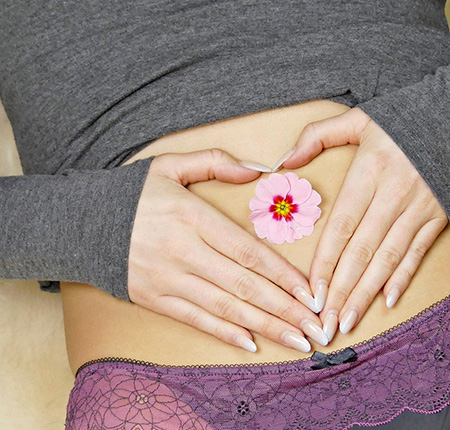
Every woman's body follows its own rhythm, and periods don't always look the same. Sometimes they're heavy, sometimes lighter. But throughout your life, your period is a subtle mirror of your inner balance. When your menstrual flow becomes less frequent or almost disappears completely, it's possible that your body is telling you, in its own way, that it needs more attention.
In this article, we'll talk about hypomenorrhea, a menstrual cycle disorder that manifests itself in the loss of small amounts of blood during menstruation. Find out what can cause such a change, how to recognize it, and how you can give your body the support it needs.
What is hypomenorrhea?
Hypomenorrhea is a menstrual cycle disorder characterized by unusually light menstrual flow.
In women with a healthy menstrual cycle, menstruation lasts an average of 2 to 7 days. The amount of blood lost during this period is normally between 30 and 80 ml. But when menstruation lasts less than 3 days, you lose less than 30 ml of blood and use significantly fewer menstrual products than usual, we can talk about hypomenorrhea.

Depending on when it begins, hypomenorrhea is classified into two categories, namely primary and secondary. Primary hypomenorrhea refers to a reduced menstrual flow from the first menstruation. If the condition appears over time, after a certain period of normal menstruation, it is called secondary hypomenorrhea.
How hypomenorrhea occurs - Causes
There are times when hypomenorrhea is normal, such as the onset of the menstrual cycle or premenopause. In adolescents, it is normal for menstrual flow to be lighter during the first few periods until the cycle becomes regular. Before menopause, it is also normal for menstrual flow to decrease as estrogen production decreases.
But there are many other situations throughout life in which hypomenorrhea can indicate a hormonal change or a problem with the uterine lining. These can be associated with factors such as stress, sudden weight changes, or the use of certain contraceptive methods. Here are the most common causes:
- Physiological factors: a reduction in menstrual flow due to hormonal changes is normal during certain stages of life such as puberty, premenopause, pregnancy, and breastfeeding.
- Hormonal imbalances: low estrogen levels can lead to thinning of the endometrium, high testosterone levels can affect ovulation (for example, in patients with polycystic ovary syndrome), and thyroid disorders such as hypothyroidism and hyperthyroidism can affect the entire hormonal system. All of these changes can cause a reduction in menstrual flow.
- Hormonal contraceptives: Birth control pills, the IUD, and other hormonal contraceptive methods thin the uterine lining to prevent pregnancy, and are among the most common causes of hypomenorrhea. When the body has less uterine lining to shed during menstruation, it is normal for menstrual flow to be reduced.
- Uterine conditions: uterine synechiae or injuries caused to the uterine cavity following curettage or other previous surgical interventions can cause hypomenorrhea.
- Other causes: stress, sudden weight loss, intense exercise, anemia.
Complications and risks of hypomenorrhea
Hypomenorrhea itself is not a serious health problem, but it is a menstrual cycle disorder that can signal the presence of other conditions. It can be a specific symptom of other problems, such as hormonal imbalances or uterine conditions that, if left untreated, can lead to serious complications.
Infertility and early menopause are the most common consequences. Conditions that cause hypomenorrhea can also lead to severe pain, abnormal intermenstrual bleeding, and other menstrual cycle disorders. Over time, these changes can also have psychological implications, such as decreased self-esteem, lack of sexual appetite, and even the onset of depression.
Symptoms associated with hypomenorrhea
Reduced menstrual flow and shortened periods are the most obvious symptoms associated with hypomenorrhea. Reduced menstrual flow is defined as either losing less than 30 ml of blood during a period or losing 20% less than in previous periods.
In addition to these clinical signs, other symptoms may also occur:
- Mild or moderate pelvic pain , especially when hypomenorrhea occurs as a result of uterine conditions.
- Infertility , when hypomenorrhea is related to lack of ovulation or thinning of the endometrium.
- Hormonal disorders associated with lack of ovulation or very irregular menstrual cycles.
Hypomenorrhea may also be accompanied by systemic symptoms such as fatigue, mood swings, insomnia, acne, and other signs of hormonal imbalances.

For many women, these changes can come with emotional implications and affect their quality of life. Hypomenorrhea can be associated with high levels of stress, anxiety, or low self-esteem, especially if difficulties with conception occur.
When to see a doctor for hypomenorrhea
Periods can vary from month to month depending on lifestyle, stress levels, and other factors, and light menstrual flow isn't always a cause for concern. But it's a good idea to contact your doctor if:
- Menstrual flow has suddenly and significantly reduced
- You have infrequent and irregular periods.
- Menstruation is accompanied by severe pain
- Do you think you might be pregnant?
- You are not pregnant, but your period is absent for 3 consecutive months
- You have vaginal bleeding outside of your period.
How is hypomenorrhea diagnosed?
The diagnosis of hypomenorrhea is primarily based on the patient's medical history and gynecological examination. The doctor will ask you questions about your menstrual flow and the length of your previous periods, perform a gynecological examination, and may then recommend other investigations:
- Transvaginal ultrasound, to evaluate the uterus, ovaries and detect possible uterine conditions.
- Hormonal analyses, to identify possible hormonal imbalances.
- Hysteroscopy, for careful examination of the uterine cavity, especially if there are suspicions of uterine synechiae or other lesions.
Treatment for hypomenorrhea
When the cause of hypomenorrhea is physiological, for example during puberty or premenopause, no intervention is often needed. In any other situation, treatment is always prescribed depending on the cause that caused the change in menstrual flow.
In the case of a hormonal imbalance, the doctor may recommend hormone therapy to regulate estrogen or progesterone levels.
If the hysteroscopy confirms the presence of uterine fibroids or polyps and these formations are associated with hypomenorrhea, they may be removed during the procedure. Surgery may also be recommended if abnormal endometrial tissue needs to be removed.
How to prevent hypomenorrhea
Many of the health problems that lead to hypomenorrhea, such as hormonal imbalances, excessive stress, anemia, or sudden weight fluctuations, can be prevented with the help of a more balanced lifestyle.
Try to have a nutritious diet, with foods rich in vitamins and minerals, to maintain a normal weight and avoid deficiencies.
Avoid restrictive diets and excessive exercise to prevent sudden weight loss. Instead, opt for moderate-intensity exercise for an active lifestyle, try to avoid stress and overexertion, and prioritize rest.
Last but not least, get regular tests and go for periodic gynecological checkups to identify any health problems early and prevent complications.

Frequently asked questions about hypomenorrhea
Still have questions about hypomenorrhea? We hope to provide you with answers below. In this section, we answer the most frequently asked questions about reduced menstrual flow, how to recognize hypomenorrhea, and how it affects your life.
How do you distinguish hypomenorrhea from other menstrual disorders?
Hypomenorrhea refers to a decrease in the amount of blood you shed during menstruation, or a reduction in the duration of menstrual bleeding to 1–2 days. Unlike amenorrhea, where menstruation is completely absent, or oligomenorrhea, where bleeding occurs at intervals greater than 35 days, hypomenorrhea involves the presence of menstruation, but in much smaller amounts.
For a correct diagnosis, it is best to go to a gynecological consultation, where the doctor can identify whether it is a normal change or a disorder that requires treatment.
How short or scanty does menstruation have to be to be considered hypomenorrhea?
On average, a normal period lasts between 3 and 7 days, with a total amount of blood lost between 30 and 80 ml. Hypomenorrhea is considered when bleeding lasts less than 3 days, or when you lose a significantly smaller amount of blood, namely under 30 ml or 20% less than in previous periods.
If these changes persist over several consecutive cycles, a gynecological consultation is recommended.
Can hypomenorrhea affect fertility?
Yes, if hypomenorrhea is associated with a lack of ovulation, low estrogen levels, or thinning of the endometrium, it can become an obstacle to achieving pregnancy. Anovulatory cycles reduce the chances of conception, while a thin endometrium can prevent the implantation of a fertilized egg. In both situations, fertility can be affected.
Does hypomenorrhea only occur at certain ages?
Hypomenorrhea can occur at any age as long as you are menstruating, but it is more common during puberty, when hormone levels fluctuate and your cycle is still regulating, and in premenopause, when estrogen levels gradually decrease. If it occurs at other stages of life without an obvious physiological cause, such as pregnancy or breastfeeding, medical consultation is recommended.
Can stress or weight loss cause hypomenorrhea?
Yes. Chronic stress and sudden weight loss can affect the levels of hormones responsible for menstruation and the menstrual cycle. When the body is under intense physical or emotional stress, the body can reduce the production of estrogen and progesterone, and the endometrium becomes thinner. These changes can cause periods to be shorter and flow to be less.
What investigations are necessary to diagnose hypomenorrhea?
After evaluating your medical history and gynecological examination, your doctor may recommend other blood tests to evaluate hormone levels, a transvaginal ultrasound, or a hysteroscopy. These additional tests are aimed at confirming the diagnosis, identifying the exact cause, and determining the appropriate treatment.
Can hypomenorrhea return to normal on its own?
When caused by temporary factors such as stress, weight changes, or the use of hormonal contraceptives, menstruation may regulate itself if hormone levels return to normal. If hypomenorrhea persists for several months or is associated with other symptoms, a medical check-up is recommended for diagnosis and treatment.
Photo source: Pexels.com & Pixabay.com






















